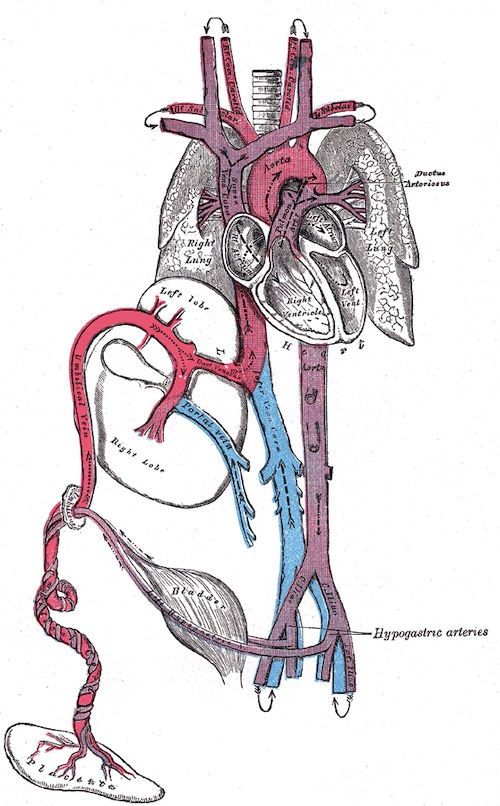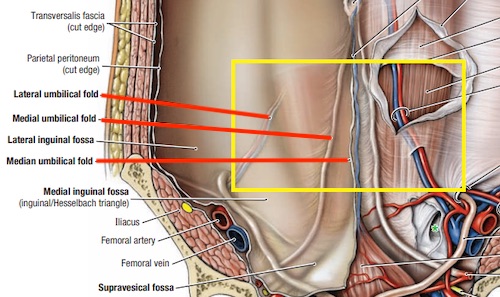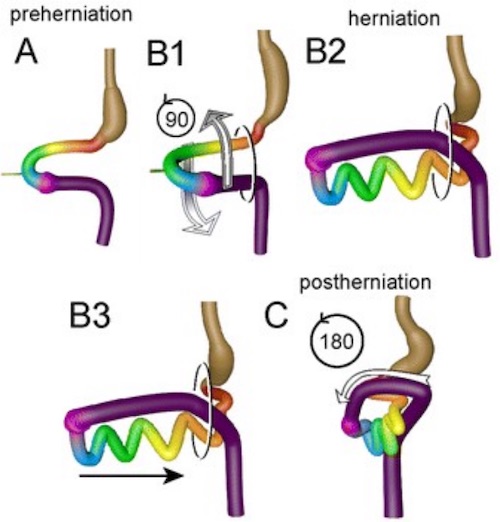Pediatric Surgery: Anatomy & Physiology
Anatomy
Fetal Circulation
- Ductus Arteriosus
- Left Pulmonary Artery to Descending Aorta
- Bypass Lungs
- Prostaglandin E1 Keeps Open
- Ductus Venosum
- Portal Vein to IVC
- Bypass Liver
- Umbilical Arteries (x2)
- From Internal Iliac Artery
- To Placenta
- Umbilical Vein (x1)
- From Placenta
- To Portal Vein/IVC

Fetal Circulation 1
Anatomic Remnants
- Vitelline (Omphalomesenteric) Duct – Fully Obliterates
- Yolk Sac to Midgut
- Allantois/Urachus – Median Umbilical Fold
- Bladder to Umbilical Cord
- Urachus is the Fibrous Remnant
- Umbilical Arteries – Medial Umbilical Folds
- Umbilical Veins – Falciform Ligament
- Lateral Umbilical Folds Contain Epigastric Vessels (Remain Patent)

Umbilical Ligaments 2
Gut Embryology
- Foregut
- GI Tract: Esophagus to Proximal Duodenum (To Ampulla of Vater)
- Organs: Liver, Gallbladder, Bile Ducts, Pancreas & Lungs
- Arterial Supply: Celiac Artery
- Hepatic Portal Drainage: Splenic Vein
- Midgut
- GI Tract: Distal Duodenum to Distal 1/3 Transverse Colon
- Arterial Supply: Superior Mesenteric Artery
- Hepatic Portal Drainage: Superior Mesenteric Vein
- Rotates 270 Degrees Counterclockwise
- Hindgut
- GI Tract: Distal 1/3 Transverse Colon to Anal Canal
- Arterial Supply: Inferior Mesenteric Artery
- Hepatic Portal Drainage: Inferior Mesenteric Vein

Classic “En-Bloc Rotation” Model of Gut Morphogenesis: Midgut Herniates and Rotates 90-Degrees (B1), Forms Loops (B2), & Slides Back into the Abdomen (B3). The Midgut Then Rotates an Additional 180-Degrees to its Final Position (C). 3
Branchial Apparatus Embryologic Derivatives
- Pharyngeal Clefts:
- First: External Acoustic Meatus
- Second-Third-Fourth: Cervical Sinus
- Pharyngeal Pouches:
- First: Middle Ear & Eustachian Tube
- Second: Palatine Tonsil
- Third: Thymus & Inferior Parathyroid
- Fourth: Superior Parathyroid & C Cells of Thyroid
- Pharyngeal Arches:
- Form Bones, Muscles, Arteries & Multiple Cranial Nerves

Branchial Apparatus 4
Physiologic Differences
Pediatric Vital Signs
| Age | HR | Systolic BP | RR |
| Newborn | 120-160 | 50-70 | 30-50 |
| 1-12 Months (Infant) | 80-140 | 70-100 | 20-30 |
| 1-3 Years (Toddler) | 80-130 | 80-110 | 20-30 |
| 3-5 Years | 80-120 | 80-110 | 20-30 |
| 6-13 Years | 70-110 | 80-120 | 20-30 |
| ≥ 14 Years | 55-90 | 90-120 | 12-20 |
Respiratory Physiologic Differences
- Higher Respiratory Rate
- Obligate Nose Breathers (Cannot Breathe Through Mouth)
Cardiovascular Physiologic Differences
- Higher Heart Rate
- Lower Blood Pressure
- Hypotension Definition: < 70 mmHg + (2 x Age in Years)
- Compensation:
- Better Early Compensation
- Rapidly Decompensate
- Cardiac Output Compensation is Maintained by Increased Heart Rate (Stroke Volume Minimally Changed)
Renal Physiologic Differences
- Impaired Renal Function (GFR < Half of Adults)
- Obligatory Diuresis & Salt Excretion
- Impaired Hormone Sensitivity
Gastrointestinal Physiologic Differences
- Decreased Capacity to Conjugate Bilirubin
General Physiologic Differences
- Larger Surface Area:Mass Ratio (Up to 3x) – High Risk for Hypothermia
General Considerations
Pediatric Immunity
- IgG: Crosses Placenta
- IgA: Secreted in Breast Milk
Most Common Pediatric Malignancies
- Peds Malignancy: Leukemia (ALL)
- Solid Tumor: CNS Tumors
- Abdominal Tumor < 2 Yr & Overall: Neuroblastoma
- Abdominal Tumor > 2 Yr: Nephroblastoma (Wilms)
- Lung Tumor: Carcinoid
- Larynx Tumor: Laryngeal Papillomatosis
References
- Gray H. Anatomy of the Human Body (1918). Public Domain.
- Dmcmdissa. Wikimedia Commons. (License: CC BY-SA-4.0)
- Soffers JH, Hikspoors JP, Mekonen HK, Koehler SE, Lamers WH. The growth pattern of the human intestine and its mesentery. BMC Dev Biol. 2015 Aug 22;15:31. (License: CC BY-4.0)
- Austanfell L. Wikimedia Commons. (License: CC BY-SA-3.0)